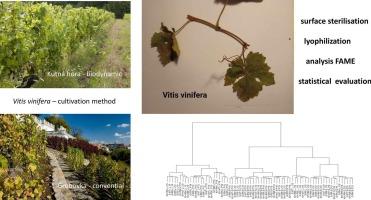Comparative methods to identify variations in membrane fatty acids reflecting microbial community differences
IF 1.9
4区 生物学
Q4 BIOCHEMICAL RESEARCH METHODS
引用次数: 0
Abstract
This study presents a novel application of fatty acid methyl ester (FAME) profiling to monitor and characterize seasonal and spatial dynamics in the endophytic microbial communities of grapevine (Vitis vinifera). Using gas chromatography with flame ionization detection, we quantified selected FAMEs in leaves and stems from four grapevine varieties sampled across different seasons and farming systems (biodynamic vs. conventional). Our results show that plant organ type and season are the dominant factors shaping endophytic community composition and abundance, with spring leaves harbouring the highest levels and winter stems the lowest. This approach provides a rapid, cultivation-independent method for detecting shifts in endophytic communities, offering new opportunities for monitoring plant health, evaluating sustainable viticulture practices, and identifying conditions that foster beneficial plant–microbe interactions.

鉴定反映微生物群落差异的膜脂肪酸变化的比较方法。
本研究提出了一种新的应用脂肪酸甲酯(FAME)分析来监测和表征葡萄(Vitis vinifera)内生微生物群落的季节和空间动态。利用气相色谱与火焰电离检测,我们定量了四个葡萄品种在不同季节和耕作系统(生物动力与传统)中取样的叶片和茎中的FAMEs。结果表明,植物器官类型和季节是影响植物内生菌群落组成和丰度的主要因素,其中春季叶片最高,冬季茎部最低。该方法为检测内生菌群落的变化提供了一种快速、独立于栽培的方法,为监测植物健康、评估可持续葡萄栽培实践和确定促进有益植物-微生物相互作用的条件提供了新的机会。
本文章由计算机程序翻译,如有差异,请以英文原文为准。
求助全文
约1分钟内获得全文
求助全文
来源期刊

Journal of microbiological methods
生物-生化研究方法
CiteScore
4.30
自引率
4.50%
发文量
151
审稿时长
29 days
期刊介绍:
The Journal of Microbiological Methods publishes scholarly and original articles, notes and review articles. These articles must include novel and/or state-of-the-art methods, or significant improvements to existing methods. Novel and innovative applications of current methods that are validated and useful will also be published. JMM strives for scholarship, innovation and excellence. This demands scientific rigour, the best available methods and technologies, correctly replicated experiments/tests, the inclusion of proper controls, calibrations, and the correct statistical analysis. The presentation of the data must support the interpretation of the method/approach.
All aspects of microbiology are covered, except virology. These include agricultural microbiology, applied and environmental microbiology, bioassays, bioinformatics, biotechnology, biochemical microbiology, clinical microbiology, diagnostics, food monitoring and quality control microbiology, microbial genetics and genomics, geomicrobiology, microbiome methods regardless of habitat, high through-put sequencing methods and analysis, microbial pathogenesis and host responses, metabolomics, metagenomics, metaproteomics, microbial ecology and diversity, microbial physiology, microbial ultra-structure, microscopic and imaging methods, molecular microbiology, mycology, novel mathematical microbiology and modelling, parasitology, plant-microbe interactions, protein markers/profiles, proteomics, pyrosequencing, public health microbiology, radioisotopes applied to microbiology, robotics applied to microbiological methods,rumen microbiology, microbiological methods for space missions and extreme environments, sampling methods and samplers, soil and sediment microbiology, transcriptomics, veterinary microbiology, sero-diagnostics and typing/identification.
 求助内容:
求助内容: 应助结果提醒方式:
应助结果提醒方式:


